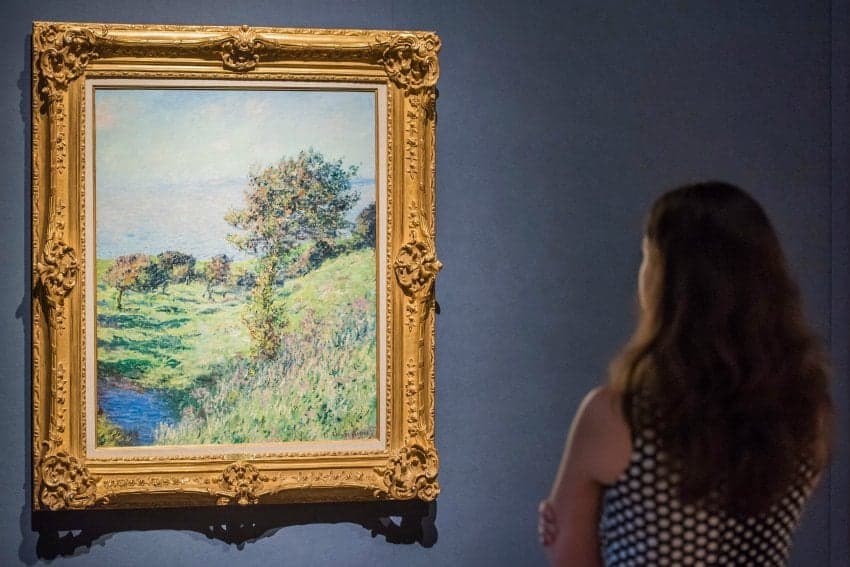Is Investing in Fine Art Safe? [Masterworks Review]
(This page may contain affiliate links and we may earn fees from qualifying purchases at no additional cost to you. See our Disclosure for more info.)
This article is sponsored by Masterworks. All opinions are our own.
Now that you’ve been investing in the stock market for a while, you’re thinking about diversifying into alternative investments.
You might decide to start with peer-to-peer lending. Although investing in real estate or tax liens might interest you more.
You can also buy gold or cryptocurrency, antiques, or rare stamps.
But what about buying fine art?
While you might think it’s out of your price range, thanks to Masterworks – ordinary investors can invest in masterpieces by famous artists such as Andy Warhol, Pablo Picasso, or Claude Monet.
Why Do People Invest in Fine Art?
Buying art is one thing. Investing in a work of art is certainly another.
You buy art for its appeal, filling the walls of your home with nary a glimmer of hope the artist becomes famous.
Collectors of artwork, however, purchase works not only for their beauty and desirability but for their potential investment returns as well.

Investing in alternative tangible assets like art is one-way people diversify their portfolios from traditional asset classes.
According to the Deloitte Luxembourg & ArtTactic Art & Finance Report, 88% of wealth managers think art should be included as part of a wealth management offering.
Blue-chip art is works produced by famous artists, that are of great value and “expected to hold or increase in value, regardless of the economic ups and downs.”
Historically, investing in blue-chip art was reserved for the ultra-wealthy. Uber affluent investors buy legendary masterpieces for their collections, often removing them from public display.
Masterworks wants to change that by “opening the doors to top-tier, blue-chip art investments to everyone.”
Masterworks Makes Investing in Works of Art Possible
Founded in 2017, Masterworks provides investors the opportunity to buy shares of world-renowned paintings for as low as $20 (with a minimum of $1,000 invested to start).
Think of it as crowdfunding for works of art, similar to REITs in real estate investing.
Instead of needing great wealth to invest, you can purchase interests (or shares) in a blue-chip (multi-million dollar) painting similar to the way you buy shares in public companies.
This makes investing in works of art possible for us ordinary investors.
What's the Process for Investing in Shares of Artwork?

The process begins with the Masterworks team selecting a piece of art. They attempt to buy blue-chip paintings with appreciation rates between 9-15% below their market value through auctions.
Once purchased, Masterworks files it as a qualified security offering with the SEC and FINRA. After qualification, they will list the artwork on their platform. Fractional shares sell for $20.
When investors buy shares, the platform will allow them to track the price appreciation of their work of art over time.
Although Masterworks intends to own each masterpiece for at least five to ten years, they will hold a transparent online shareholder vote if a collector submits an offer to buy the piece. (No Masterworks investor can purchase over 20% of one particular offering.)
If a majority of shareholders votes to sell, the distribution of proceeds (after expenses) to shareholders will occur after the sale.
The only qualified holding available now is the Andy Warhol 1 Colored Marilyn (reversal series). However, a Monet is in pre-qualification status, and another offering will be filed for soon.
Masterworks hopes to acquire new artwork every couple of months to allow investors the opportunity to diversify their portfolios.
Eventually, Masterworks plans to house their paintings in a free gallery and open to the public.
Benefits of Investing With Masterworks
In addition to owning shares in paintings by some of the most famous artists in the world, there are other advantages to investing in blue-chip art.
- Outperforms the stock market and helps protects against inflation. According to Artprice, blue-chip artwork (defined as those paintings by the top 100 artists in terms of sales volume) has outperformed the S&P 500 by more than 250% from Jan 1, 2000–Dec 31, 2018. The Wall Street Journal reported that the total return for blue-chip artwork in 2018 was 10.6% compared to an estimated -5.1% for the S & P 500. During times of inflation and rising interest rates, art has been an excellent hedge, easily outperforming stocks.
- Low correlation to market volatility. Fine art is a relatively stable asset. It's not generally affected by daily stock market conditions and economic and political unrest.
- Ordinary investors have easy access. You don’t have to be a high-earner or have a high net worth to invest with Masterworks. With a minimum investment, you can purchase $20 shares of history. Just go to masterworks.io, request an invite and get started.
- Future diversification. While Masterworks only has one qualified offering right now to invest in, they have another in pre-qualification status. They plan to add a new painting every few months, which will allow investors a better chance to diversify their artwork investments.
Drawbacks To Investing With Masterworks
While owning a piece of a painting by one of the best-selling artists of all time sounds exciting, it’s essential to understand that this alternative investment is high risk.
The disclosures on the Masterworks website explain several things you should be mindful of.
Some of the notable disadvantages to this investment include:
- You could lose money. This is a unique and untested business model that might fail. If liquidation of an artwork happens at an inopportune time, paintings don’t increase in value, or if appreciation doesn’t cover expenses, investors can lose money. *Note: If you can’t afford to lose the money you plan to put in, you should skip this type of investment.
- It’s an illiquid investment. Investors only realize returns when a painting is sold or when selling their shares in the future (which may never be possible or may have high costs.) The plan is to hold paintings for at least five to ten years before investors vote to sell. So you need to plan on keeping these investments for indefinite periods.
- You’re investing in one painting. While you might believe you're diversifying with alternative investments, your investing money in one piece of art – not in a gallery of them. The painting is also at risk for things such as theft or natural disasters – and insurance may not cover some losses.
- Fees and other costs will reduce returns. You’ll pay a 1.5% annual fee, and 20% of the profit from the sale of each painting goes to Masterworks. These costs will cut into returns on your investment when the painting eventually sells.
Final Thoughts On Investing in Fine Art with Masterworks
If you’re an art enthusiast and your interest in alternative investments is piqued, Masterworks provides a great way to invest in a masterpiece and own a part of history without a significant investment.
Investing in Masterworks offerings does involve a high degree of risk, however. You need to understand the disadvantages of this type of investment and accept it as a long-term strategy.
While the potential rewards are high, it could take a decade or more to realize any returns on your investment.
Investing in shares of fine art is just one way to diversify a small part of your portfolio. But you should own plenty of other holdings to be truly diversified.
Alternative investments shouldn’t replace your traditional retirement portfolio of cash or cash equivalents, stocks (equities), and bonds focused on growth and building wealth for the future.
Our advice? Speak with a financial professional who can assist you with a variety of investments. Also, talk with a tax professional about alternative investments of interest to you.
Finally, to protect your assets further, research the investment professionals you plan to work with.
Will you be paying them a fee or are they earning commissions? Always ensure you know how they earn their money so you understand if it could impact their advice.

Written by Women Who Money Cofounders Vicki Cook and Amy Blacklock.
Amy and Vicki are the coauthors of Estate Planning 101, From Avoiding Probate and Assessing Assets to Establishing Directives and Understanding Taxes, Your Essential Primer to Estate Planning, from Adams Media.


